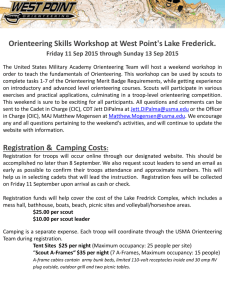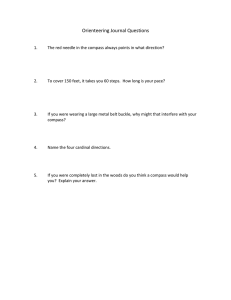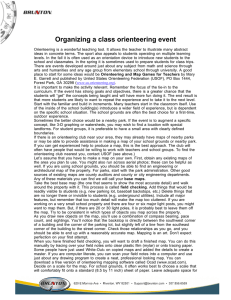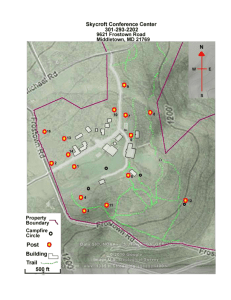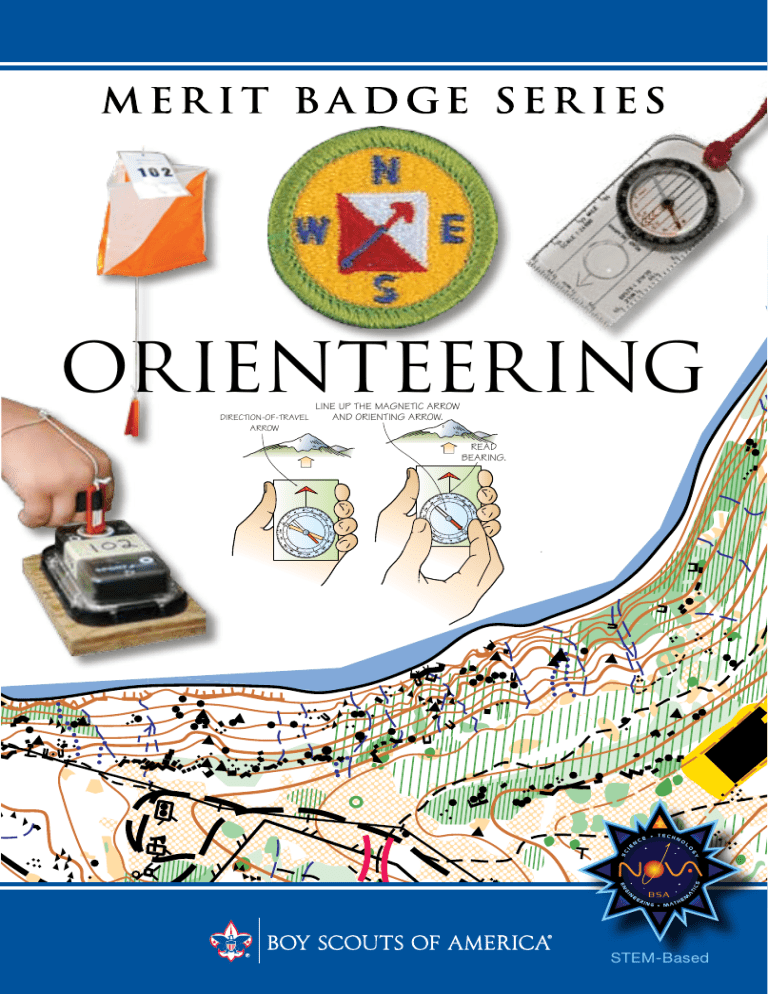
Orienteering Direction-of-travel arrow Line up the magnetic arrow and orienting arrow. Read bearing. STEM-Based BOY SCOUTS OF AMERICA MERIT BADGE SERIES ORIENTEERING “Enhancing our youths’ competitive edge through merit badges” Requirements 1. Show that you know first aid for the types of injuries that could occur while orienteering, including cuts, scratches, blisters, snakebite, insect stings, tick bites, heat and cold reactions (sunburn, heatstroke, heat exhaustion, hypothermia), and dehydration. Explain to your counselor why you should be able to identify poisonous plants and poisonous animals that are found in your area. 2. Explain what orienteering is. 3. Do the following: a. Explain how a compass works. Describe the features of an orienteering compass. b. In the field, show how to take a compass bearing and follow it. 4. Do the following: a. Explain how a topographic map shows terrain features. Point out and name five terrain features on a map and in the field. b. Point out and name 10 symbols on a topographic map. c. Explain the meaning of declination. Tell why you must consider declination when using map and compass together. d. Show a topographic map with magnetic north-south lines. e. Show how to measure distances on a map using an orienteering compass. f. Show how to orient a map using a compass. 35925 ISBN 978-0-8395-3385-6 ©2012 Boy Scouts of America 2014 Printing 5. Set up a 100-meter pace course. Determine your walking and running pace for 100 meters. Tell why it is important to pace-count. 6. Do the following: a. Identify 20 international control description symbols. Tell the meaning of each symbol. b. Show a control description sheet and explain the information provided. c. Explain the following terms and tell when you would use them: attack point, collecting feature, catching feature, aiming off, contouring, reading ahead, handrail, relocation, rough versus fine orienteering. 7. Do the following: a. Take part in three orienteering events. One of these must be a cross-country course. b. After each event, write a report with (1) a copy of the master map and control description sheet, (2) a copy of the route you took on the course, (3) a discussion of how you could improve your time between control points, and (4) a list of your major weaknesses on this course. Describe what you could do to improve. 8. Do ONE of the following: a. Set up a cross-country course that is at least 2,000 meters long with at least five control markers. Prepare the master map and control description sheet. b. Set up a score orienteering course with at least 12 control points and a time limit of at least 60 minutes. Set point values for each control. Prepare the master map and control description sheet. 9. Act as an official during an orienteering event. This may be during the running of the course you set up for requirement 8. 10. Teach orienteering techniques to your patrol, troop, or crew. Orienteering 3 Orienteering Resources. Orienteering Resources Scouting Literature Boy Scout Handbook; Fieldbook; Deck of First Aid; Emergency First Aid pocket guide; Be Prepared First Aid Book Visit the BoyScouts of America’s official retail website (with your parent’s permission) at http:// www.scoutstuff.org for a complete listing of all merit badge pamphlets and other helpful Scouting materials and supplies. Books Bagness, Martin. Outward Bound Orienteering Handbook. Lyon’s Press, 1995. Boga, Steven. Orienteering: The Sport of Navigating With Map and Compass. Stackpole Books, 1997. Bratt, Ian. Orienteering: The Essential Guide to Equipment and Techniques. Stackpole Books, 2002. Kjellström, Björn. Be Expert With Map and Compass: The Complete Orienteering Handbook. Hungry Minds/John Wiley & Sons, 2009. McNeill, Carol, Tom Renfrew, and Jean Cory-Wright. Teaching Orienteering, 2nd ed. Human Kinetics, 1998. 74 Orienteering McNeill, Carol. Orienteering (The Skills of the Game). Crowood Press, 1996. Palmer, Peter, ed. The Complete Orienteering Manual. Crowood Press, 1998. Renfrew, Tom. Orienteering. Human Kinetics, 1996. Videocassettes Braggins and Pearson. Trail Orienteering, 21 minutes. A&E Orienteering Inc., 1997. Cassone, Chris. Orienteering—All Welcome, 12 minutes. A&E Orienteering Inc., 1998. Organizations and Websites Canadian Orienteering Federation Website: http://www.orienteering.ca Orienteering USA P.O. Box 1444 Forest Park, GA 30298-1444 Website: http://www.us.orienteering.org U.S. Geological Survey 12201 Sunrise Valley Drive Reston, VA 20192 Telephone: 703-648-5953 Website: http://www.usgs.gov .Orienteering Resources Equipment Sources A&E Orienteering P.O. Box 443 Baldwin City, KS 66006 Telephone: 785-594-3516 Website: http://www.aeorienteering.com Army Navy Sales Website: http://www.armynavysales.com Berman’s Orienteering Supply 23 Fayette St. Cambridge, MA 02139 Telephone: 617-868-7416 The Compass Store Website: http://www.thecompassstore.com Orienteering Unlimited Inc. 3 Jan Ridge Road Somers, NY 10589-3007 Telephone: 914-248-5957 Website: http://www.orienteeringunlimited.com U.S. Geological Survey Topographic Maps A local sporting goods store or bookstore may carry topographic maps of your area. You can also find local dealers in your state at the U.S. Geological Survey website, http://www.usgs.gov. Or send a postcard to the National Cartographic Information Center, 507 National Center, 12201 Sunrise Valley Drive, Reston, VA 20192. Ask for a free topographic map index circular of your state. The index circular is a small map of the state divided into sections called quadrangles. Each quadrangle is a separate map. Find out which quadrangles cover the area in which you want to orienteer. Order the map by giving the name of the quadrangle and include a money order or check for payment. Send your order to Branch Distribution, U.S. Geological Survey, Box 25286, Federal Center, Denver, CO 80225. Scarborough Orienteering 3015 Holyrood Drive Oakland, CA 94611 Telephone: 510-530-3059 Website: http://orienteer.com Uncle Sam’s Army Navy Outfitters Website: http://www.armynavydeals.com Orienteering 75
